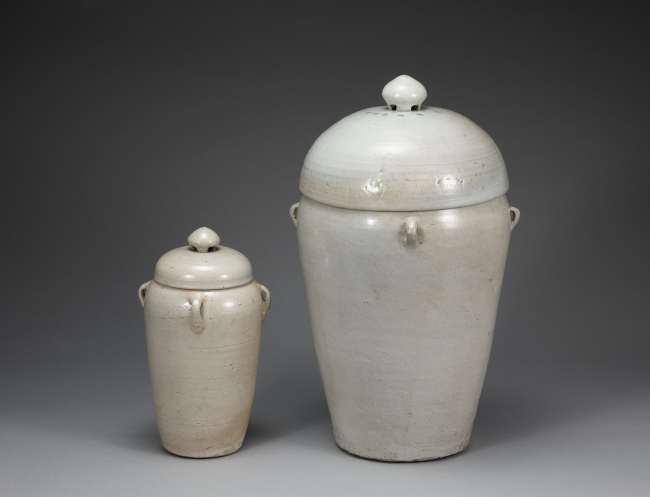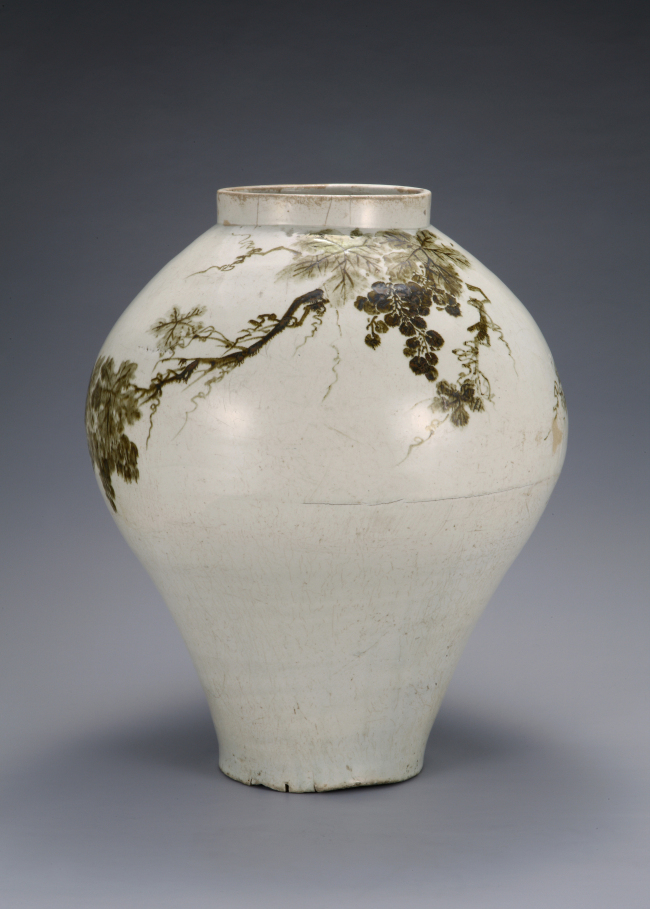“Careful in speech, yet enough to reveal the entire world, and follow murkiness and clearness from time to time. Its emptiness may allow it to fill all things, and its whiteness in quality may reveal its nature.”
The poem written on a 17th-century white porcelain work of art decorated in underglaze iron sums up the neo-Confucian virtues of austerity, humility and purity that Joseon scholars upheld. The milky white body, minimal decoration and voluptuous simple curves of white porcelain were some aesthetic representations of Joseon scholars to express their neo-Confucian ideals.
They made a variety of white wares to be used in various occasions for the birth of a baby, weddings, funerals and ancestral rites. The white porcelain wares accompanied important stages of one’s life, functioning as a practical and symbolic container for the austere life they pursued.
The exhibition at Ewha Womans University Museum brings together some 600 works of white porcelain from the Joseon period (1392-1910) used for diverse occasions during the course of a life.
 |
| Placenta jars, 1481, Joseon. (Ewha Womans University Museum) |
The museum, established by Protestant missionaries in 1903, celebrates the 80th anniversary of its founding. It is a treasure trove of more than 250,000 artifacts that date back from prehistoric times to the major kingdoms of old Korea.
This anniversary exhibition traces lives in the Joseon period, especially those of royal families and higher classes, represented in the use of white porcelain.
“White porcelain wares are made at more than 130 degrees Celsius inside a kiln while the blue green celadon was made under 120 degrees Celsius. White porcelain wares were stronger and more durable than Goryeo celadons. The strong quality and the simple aesthetics of white porcelain wares were considered to best reflect the neo-Confucian values of Joseon,” said Kim Joo-yeon, curator of the museum. White porcelain became widely produced during the early Joseon period, substituting for the celadons of Goryeo (918-1392).
When royal babies were born, their placentas were buried according to a royal ritual procedure. People of Joseon believed that burying a placenta in good soil guarantees a healthy life for the baby. White porcelain jars used to contain placentas had simple features without any pattern or decoration, with just a lid and small handles.
A painting and a set of white tableware show a glimpse of the royal dining culture of Joseon. The painting dated to 1720, depicts King Sukjong’s ceremony with officials aged more than 70. Officials here are being served with individual dining tables, each with diverse dishes placed on high-footed bowls and plates.
 |
| Jar with grapevine design in underglaze iron, 18th-century, Joseon. (Ewha Womans University Museum) |
The actual set of high-footed rectangular and octagonal dishes used for royal ceremonies are on display at the exhibition.
“Korean food culture is known for sharing. But that was among the lower classes. The royal dining culture was different. In the royal court, dishes were served individually for each person,” said Kim.
When a royal family member died, their life was summarized on a white porcelain tablet on which their birth dates, achievements and the date of death was written. The exhibition shows three white porcelain epitaph tablets of royal concubine Yun of King Yeonsangun. Her life, inscribed in blue ink, tells that she became a royal noble consort in 1501 and earned the status of a high-ranking royal concubine later, adopted her niece as her daughter and died in 1568 at age 63.
The exhibition also features masterpieces, registered as national treasures of Korea, including the grape-patterned 18th-century white porcelain and 17th-century dragon-inscribed ceramic. More displays include round-shaped moon jars that are usually associated with the typical image of Joseon white porcelain ware and interesting porcelain pieces mimicking royal ceramics from the lower ranks.
The exhibition “White Porcelain in the Joseon Dynasty” runs until Jan. 30, 2016 at Ewha Womans University Museum. For more information, visit museum.ewha.ac.kr., or call (02) 3277-3152.
By Lee Woo-young (wylee@heraldcorp.com)



